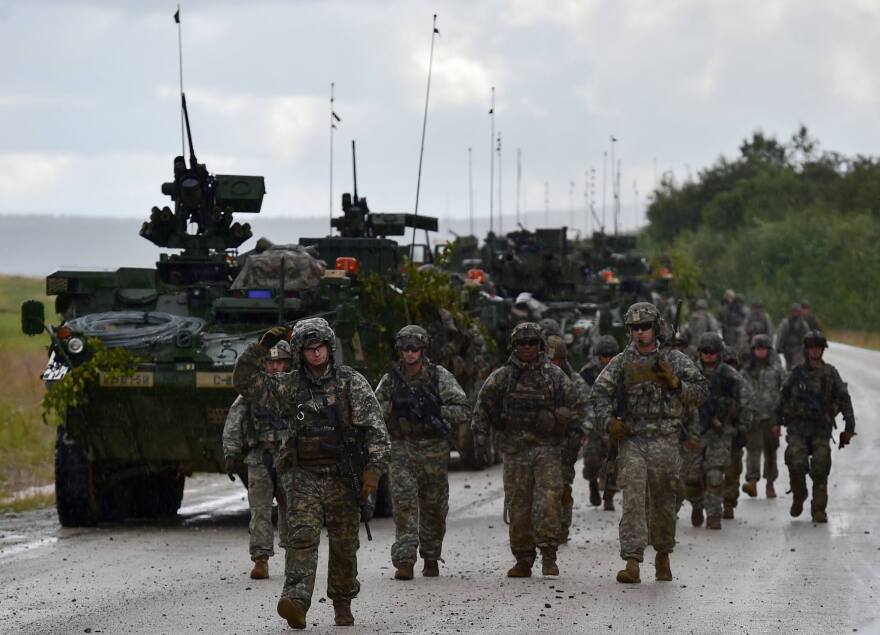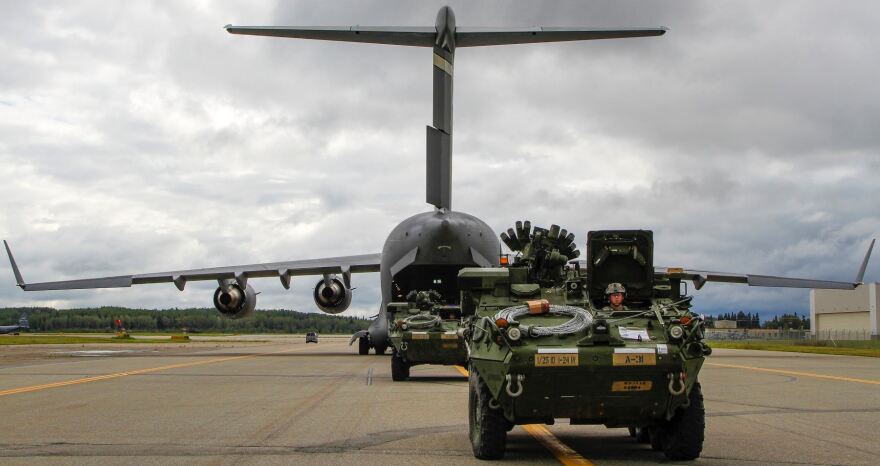Some 5,000 soldiers from around the country and Canada are headed back home after a grueling three-week field-training exercise on ranges around Fort Greely. Arctic Anvil was the biggest exercise U.S. Army-Alaska has held since 2001. It was intended to test the Stryker Brigade’s warfighting abilities. But it also challenged the soldiers who provide logistical support that make operations like Arctic Anvil happen.
Nine-hundred members of the Iowa National Guard were breaking camp last week after playing the challenging role of opposition force or “OPFOR,” against the Stryker Brigade since mid-July. Specialist Troy Chandler is with the Iowa Guard’s 1st Battalion, 133rd Infantry Regiment, and he thinks his unit held its own.
“They were formidable,” Chandler said, “but we gave ’em a fight. They didn’t expect to put up as much of a fight as we did. Seeing as how they’re active Army and we’re National Guard, they thought we were going to be pushovers. But, we showed them otherwise.”

Down the road from the camp, Corporal Lacey Richard was waiting for another truck to pull up to the fueling point she and a fellow soldier were operating. Richards is with the Iowa Guard’s 113th Cavalry Regiment, and she also was impressed – with both the Strykers and the OPFOR.
“They’ve actually been working very well together at trying to push back on each other’s enemy sides,” she said.
Richard wasn’t in the middle of those frays. She and hundreds of other soldiers participated by providing the support needed to make training exercises like Arctic Anvil happen.

“Not only do we have fuelers, but we also have cooks,” she said. “We have truck drivers that have to move personnel – they move any kind of supplies from ammo to fuel to water to food. (To) make sure that everyone kind of gets what they need.”
First Sgt. David Barrellas with the Fort Wainwright-based 539th Transportation Company says his unit kept trucks moving to and from the ranges to maintain a steady flow of supplies.
“Sixty personnel on the road; 60 returning and 60 prepping,” Barrellas said. “So while they’re prepping and coming off the road, they’re recovering every vehicle that comes back.”

And Capt. Joshua Poblete and the 574th Composite Supply Company also based at Wainwright have been pumping and purifying water from area lakes almost nonstop since mid-July.
“We’ve been providing water-purification across this whole exercise,” he said. “So that’s what everybody’s been consuming.”
It’s the kind of logistical support that’s required at many levels in order to pull off Arctic Anvil, the biggest field-training exercise held in Alaska since the old Jack Frost and Brim Frost wintertime exercises of a couple of decades ago.

“There’s a lot of people that are part of this effort, because it’s pretty substantial, and it takes everybody to make this work,” says Lt. Col. Pete Bonin, an assistant operations officer with U.S. Army Alaska. He says logistical support for Arctic Anvil extended across many jurisdictions, including “state, local, active-duty, National Guard – Alaska Guard, we’ve got the Iowa Guard – international players …”
That’s the 140 soldiers from the Third Canadian Division who also participated in Arctic Anvil. Bonin says exercise organizers were challenged to transport a couple thousand soldiers and pieces of equipment into Alaska, then on to the sprawling training ranges around Fort Greely.

“So, equipment coming into the port of Anchorage, getting it on rails, bringing it up into the Fort Wainwright area, transferring equipment to Air Force assets and then moving them down to Fort Greely,” he said. “Every mode of transportation was utilized, so the synchronization was tremendous.”
Once the units were in the field, aviators like Capt. Mike Jeter with the Fort Wainwright-based 1st of the 52nd Aviation Regiment help with transport around the ranges.
“We provide heavy lift via the Chinook, VIP support and other lift capabilities with our UH-60,” he said, “and also medevac support.

Jeter was referring to the UH-60 Blackhawk variants and big tandem-rotor CH-47 Chinooks that’ve been crisscrossing the airspace around Greely over the past few weeks. The unit’s also been flying AH-64 Apache attack helicopters for combat scenarios.
“For this particular mission,” he said, “we also had Apaches attached to our battalion, 1-52. And they helped with the attack role, which was very central to the mission 1st Stryker Brigade was trying to accomplish here.”
Fighting and winning is, after all, the point of exercises like Arctic Anvil. But Army officials say the skills honed on the training range also help soldiers respond more ably to other emergencies, such as natural disasters and humanitarian assistance.



